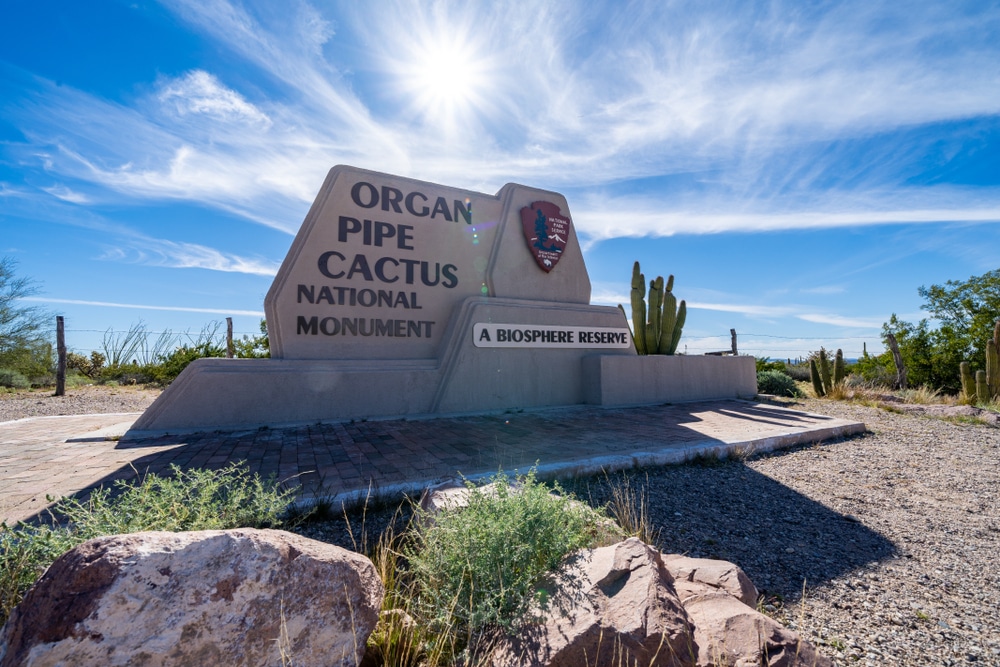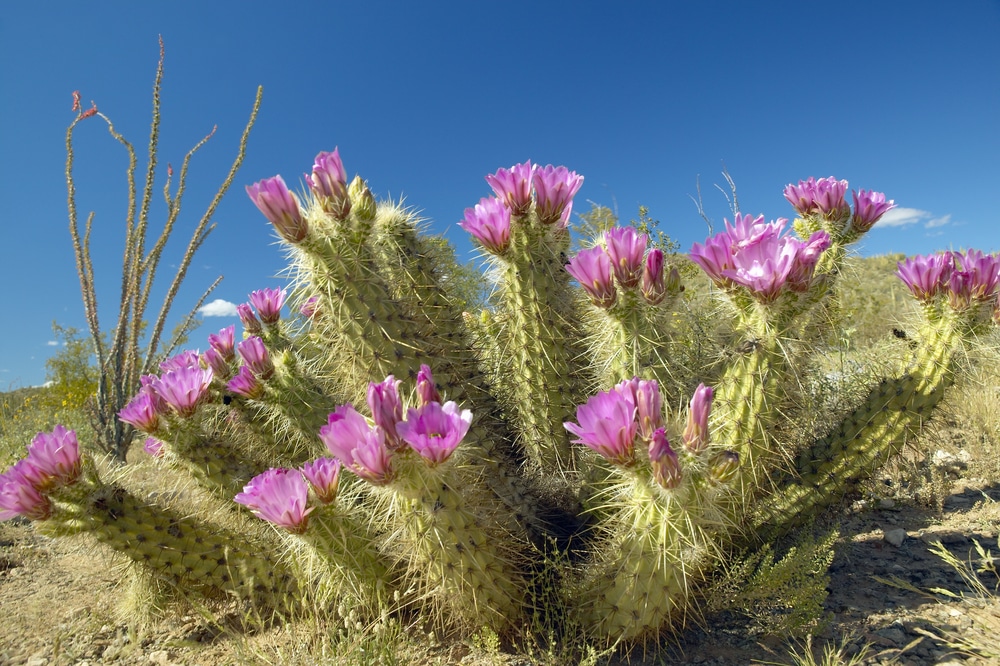Nestled in the extreme southern portion of Arizona along the border with Mexico lies one of America’s most unique protected landscapes—Organ Pipe Cactus National Monument. Established in 1937 by President Franklin D. Roosevelt, this 330,000-acre preserve represents a remarkable crossroads of natural wonder, cultural heritage, and biological diversity. The monument takes its name from the distinctive organ pipe cactus (Stenocereus thurberi), a many-stemmed columnar cactus that in the United States grows almost exclusively within the monument’s boundaries.
As the only place in the United States where the organ pipe cactus grows wild, the monument preserves a pristine portion of the Sonoran Desert ecosystem—one of the most complex and fascinating desert environments in North America. This isolated corner of Arizona represents a critical ecological transition zone where the influence of tropical Mexican ecology meets the more temperate desert systems of the American Southwest, creating a biological melting pot of extraordinary diversity.

In 1976, the United Nations designated Organ Pipe Cactus National Monument as an International Biosphere Reserve, recognizing its importance as an almost pristine example of a Sonoran Desert ecosystem. The monument protects not only a stunning desert landscape but also thousands of years of human history and cultural heritage that connect directly to indigenous peoples and more recent settlers.
For visitors seeking an authentic desert experience away from the more heavily trafficked areas of Arizona, Organ Pipe offers solitude, adventure, and immersion in a landscape that feels both ancient and alive. Whether you’re a passionate naturalist, avid hiker, photography enthusiast, or cultural history buff, this desert sanctuary provides a window into one of North America’s most distinctive ecosystems..
Explore the monument’s stunning landscapes by driving its scenic routes:

The park offers a variety of hiking trails that cater to all skill levels:

Start your visit at the Kris Eggle Visitor Center, named after a park ranger who lost his life in the line of duty. The center features:

The monument is the ancestral homeland of the Tohono O’odham Nation, and many of its trails and landmarks have cultural significance. Ranger programs and interpretive displays at the Visitor Center highlight the traditions, history, and connection of the Tohono O’odham people to the land.

With its dramatic desert landscapes, vibrant sunsets, and unique plant life, Organ Pipe Cactus National Monument is a photographer’s paradise. Ideal photo opportunities include:

The monument is home to a variety of desert wildlife, many of which are most active during early morning or evening hours. Animals you might see include:
Organ Pipe Cactus National Monument is a designated International Dark Sky Park, making it one of the best places in Arizona for stargazing. On clear nights, you can see the Milky Way, constellations, and countless stars. Bring a telescope or simply lay out a blanket to enjoy the serene desert night sky.

Stay overnight at the Twin Peaks Campground, which offers developed campsites with stunning views of the desert and surrounding mountains. The campground features:

| Category | Details |
|---|---|
| Location | Southern Arizona, along the U.S.-Mexico border, near Ajo, Arizona |
| Established | April 13, 1937 |
| Managed By | National Park Service |
| Size | Approximately 330,689 acres (133,225 hectares) |
| Main Attractions | Organ Pipe cacti, Ajo Mountain Drive, Puerto Blanco Drive, Desert View Trail |
| Significance | The only place in the U.S. where large stands of organ pipe cacti grow naturally |
| Cultural Significance | Home to ancient Hohokam and Tohono O’odham archaeological sites |
| Ecosystem | Sonoran Desert with diverse cacti, desert shrubs, and wildlife |
| Wildlife | Includes javelinas, coyotes, desert bighorn sheep, Gila monsters, and over 270 bird species |
| Trails | Popular trails include the Bull Pasture Trail, Estes Canyon Trail, and the Victoria Mine Trail |
| Nearby Landmarks | Cabeza Prieta National Wildlife Refuge, Ajo, Arizona |
| Recreation Activities | Hiking, scenic drives, birdwatching, camping, and photography |
| Climate | Hot summers, mild winters; monsoon rains occur during late summer |
| Accessibility | Visitor center and some trails are wheelchair accessible |
| Entrance Fee | $25 per vehicle (valid for 7 days; fees subject to change) |
| Camping | Twin Peaks Campground offers developed camping; backcountry camping is also allowed |
| Fun Fact | The organ pipe cactus blooms only at night, with flowers opening after sunset and closing by morning. |
Organ Pipe Cactus National Monument is located in Pima County in southwestern Arizona, approximately 150 miles southwest of Tucson and about 125 miles west of Nogales. The monument shares its southern boundary with the Mexican state of Sonora, bordering El Pinacate y Gran Desierto de Altar Biosphere Reserve—creating one of the largest protected desert regions in North America.
The monument is accessible via State Route 85, which runs north-south through the eastern portion of the park, connecting the border town of Lukeville with Ajo and eventually Phoenix. The Kris Eggle Visitor Center, named after a park ranger who lost his life in the line of duty in 2002, serves as the primary information hub and is located near the monument’s northern entrance.
For most visitors traveling from major Arizona cities:
The monument is open year-round, though visitor services may be limited during the extreme summer months when temperatures regularly exceed 110°F (43°C). The nearest commercial airport is in Tucson, though some visitors may choose to fly into Phoenix for more flight options.
Organ Pipe Cactus National Monument preserves one of the most ecologically diverse portions of the Sonoran Desert, supporting over 640 plant species, 270 bird species, and 55 mammal species. The monument’s varied topography—ranging from valley floors at about 1,000 feet to mountain peaks exceeding 4,800 feet—creates distinct ecological niches supporting this remarkable biodiversity.
The monument’s namesake, the organ pipe cactus, is the most iconic plant species within the boundaries. These distinctive cacti can grow up to 25 feet tall and live for over 150 years. Each stem grows from a central base, resembling the pipes of a church organ. They typically bloom from May through July, producing white flowers that open at night and close by mid-morning the following day, followed by sweet red fruit historically harvested by the Tohono O’odham people.
Other significant plant species include:
Saguaro Cactus (Carnegiea gigantea): The iconic symbol of the American Southwest, these massive columnar cacti can live for 150-200 years and grow up to 60 feet tall.
Senita Cactus (Lophocereus schottii): Rare in the United States, this cactus is found primarily in the southern portions of the monument.
Ironwood Trees (Olneya tesota): Ancient desert trees that can live for over 800 years and serve as crucial nurse plants for young cacti.
Ocotillo (Fouquieria splendens): These distinctive plants resemble bundles of slender dead sticks most of the year but burst into green leaves and bright red flowers within 72 hours of rainfall.
Creosote Bush (Larrea tridentata): One of the most drought-tolerant plants in North America, some specimens are thought to be several thousand years old.
The monument also contains surprising diversity, including desert grasslands at higher elevations and desert riparian areas along seasonal washes.
The monument supports a remarkable array of wildlife adapted to survive in extreme conditions:
Mammals: Desert bighorn sheep, javelina (collared peccary), mountain lions, bobcats, gray foxes, and several species of bats.
Birds: Gila woodpeckers, cactus wrens, phainopeplas, northern cardinals, great horned owls, and numerous migratory species.
Reptiles: Gila monsters, western diamond-backed rattlesnakes, desert tortoises, and various lizard species.
Amphibians: Several species of toads that emerge during the summer monsoon season.
The monument encompasses several mountain ranges, including the Ajo Range, Puerto Blanco Mountains, and Bates Mountains. These ranges are primarily composed of volcanic rock, with dramatic evidence of the region’s tumultuous geological past. Between these mountains lie valley floors covered with desert pavement and bajadas (alluvial slopes) where most of the iconic cacti grow.
Despite its remote location and challenging climate, Organ Pipe Cactus National Monument offers a wealth of recreational opportunities for visitors willing to plan accordingly.
The monument features over 150 miles of trails ranging from easy nature walks to challenging backcountry routes:
Desert View Trail: A 1.2-mile loop near the visitor center that offers an excellent introduction to Sonoran Desert ecology.
Estes Canyon/Bull Pasture Loop: A moderately strenuous 3.6-mile loop that climbs to a high desert grassland with panoramic views.
Victoria Mine Trail: A 4.5-mile round-trip hike to an abandoned mine site dating back to the 1890s.
Alamo Canyon: A 1-mile round-trip walk along a desert wash to a former ranch site, spectacular during wildflower season.
Puerto Blanco Drive Trails: Several shorter trails accessible from this scenic drive, including Senita Basin and Pinkley Peak.
For experienced backcountry hikers, the monument offers opportunities for off-trail exploration in designated wilderness areas, though this requires careful planning, navigation skills, and plenty of water.
Two primary scenic drives allow visitors to experience the monument’s diverse landscapes from the comfort of their vehicles:
Ajo Mountain Drive: A 21-mile loop road (mostly gravel) that winds through the foothills of the Ajo Mountains, offering spectacular views and access to several trailheads. This drive represents the best opportunity to see large stands of organ pipe cacti.
Puerto Blanco Drive: A 37-mile loop (fully paved sections with some primitive road segments) that traverses the western portion of the monument, showcasing diverse desert landscapes and providing access to the international border.
Both drives feature interpretive signs and pullouts that explain the natural and cultural history of the region.
Dawn and dusk offer prime opportunities for wildlife observation, particularly during the cooler months from October through April. Popular wildlife viewing spots include:
For photographers, the golden light of early morning and late afternoon creates dramatic shadows across the desert landscape, highlighting the sculptural forms of the cacti against the backdrop of the rugged mountains.
The monument offers two camping options:
Twin Peaks Campground: The main developed campground with 174 sites, restrooms with running water, and potable water sources. Sites include picnic tables and grills but no hookups. This campground is open year-round, though it becomes very hot in summer.
Alamo Campground: A primitive campground with four sites located 5 miles down Alamo Canyon Road. No water is available, and access requires a high-clearance vehicle.
Both campgrounds operate on a first-come, first-served basis during the summer months, while reservations are recommended from January through March when snowbirds and other winter visitors fill the area.
The monument’s remote location and minimal light pollution make it an exceptional destination for stargazing. On clear nights, the Milky Way is clearly visible stretching across the sky. The monument occasionally offers ranger-led night sky programs during the cooler months.
Organ Pipe Cactus National Monument preserves not only natural resources but also thousands of years of human history. Archaeological evidence suggests human presence in the region dating back at least 12,000 years.
The monument lies within the traditional homeland of the Tohono O’odham Nation (formerly known as the Papago), whose ancestors, the Hohokam, developed sophisticated desert agriculture using seasonal water sources. The Tohono O’odham have maintained a profound connection to this landscape for countless generations, utilizing desert plants for food, medicine, and materials.
Particularly significant to the Tohono O’odham are the organ pipe and saguaro cacti, whose fruits are harvested in traditional ceremonies that mark the beginning of the new year. The monument works closely with tribal representatives to protect culturally significant sites and continue traditional practices where appropriate.
Beginning in the 1850s, European-American settlers began exploiting the region’s mineral resources, establishing mines like the Victoria Mine that extracted gold, silver, and copper. Remnants of these operations can still be seen at several sites within the monument.
Ranching became a significant activity in the late 19th and early 20th centuries, with operations like the Gray Ranch utilizing desert grasslands for cattle. Several historic ranch structures remain, offering glimpses into the challenging lives of frontier families who carved out existences in this demanding landscape.
The monument’s location along the international border has shaped its development and management throughout its history. The border town of Lukeville/Sonoyta serves as a port of entry between the United States and Mexico, and the monument works cooperatively with Mexican counterparts to manage shared ecological resources.
Named in honor of a park ranger killed in the line of duty in 2002, the visitor center serves as the primary information and orientation point for monument visitors. Facilities include:
The visitor center is typically open daily from 8:00 AM to 5:00 PM during the peak season (January-March) with reduced hours during the summer months.
During the busy winter season, the monument offers a variety of ranger-led programs:
Program schedules are posted at the visitor center and campground bulletin boards.
The monument has made efforts to accommodate visitors with disabilities:
The extreme climate of the Sonoran Desert creates distinct seasonal variations that significantly impact the visitor experience.
Many consider autumn the ideal time to visit Organ Pipe. Daytime temperatures become more moderate (70s-80s°F/21-32°C), and nights cool down pleasantly. The summer monsoon season typically ends by late September, leaving the desert refreshed and often sprouting with new growth. Visitor services begin to expand from their reduced summer schedule, though crowds remain relatively light.
Winter represents the busiest visitation period. Daytime temperatures typically range from the 60s to 70s°F (15-25°C), perfect for hiking and outdoor exploration. Nights can be quite cold, occasionally dropping below freezing at higher elevations. The campground and visitor facilities operate at full capacity during these months, and advance reservations are highly recommended. Winter also brings the best visibility for distant landscape views.
Spring brings the possibility of spectacular wildflower displays, particularly if winter rains have been abundant. The timing varies annually, but peak blooming typically occurs in late March through early April. Temperatures begin to climb, with late April sometimes reaching the 90s°F (32°C+). This season represents an excellent balance between good weather and decreasing crowds.
Summer brings extreme heat, with daytime temperatures regularly exceeding 100°F (38°C) and occasionally reaching 115°F (46°C) or higher. Few visitors brave these conditions, and outdoor activities become hazardous during daylight hours. However, the summer monsoon season (July-September) brings dramatic thunderstorms and flash floods that transform the desert temporarily. The visitor center remains open with reduced hours, and camping is available but challenging due to the heat.
The desert environment presents several significant hazards that visitors should prepare for:
The most serious threat to visitors is the extreme heat combined with very low humidity. During warm months, hikers should:
During the summer monsoon season, dry washes can transform into raging torrents within minutes, even if no rain is visible in the immediate area. Visitors should:
While dangerous wildlife encounters are rare, visitors should:
The monument’s isolation means emergency services may be significantly delayed. Cell phone coverage is limited to non-existent in much of the monument. Visitors should:
Organ Pipe Cactus National Monument faces several significant conservation challenges that threaten its unique resources:
Rising temperatures and changing precipitation patterns are already impacting the monument’s fragile desert ecosystem. Some plant species are showing stress at lower elevations, and the timing of flowering and fruiting is shifting. Long-term monitoring programs track these changes to inform adaptation strategies.
The monument’s location along the international border creates unique management challenges. Infrastructure development, unauthorized vehicle traffic, and human passage have impacted sensitive habitats in some areas. The monument works closely with law enforcement agencies to minimize these impacts while fulfilling its conservation mission.
Non-native plant species like buffelgrass and Sahara mustard threaten to transform the native ecosystem by outcompeting native plants and altering fire regimes. The monument conducts ongoing efforts to control these invasives through mechanical removal and targeted treatment.
Desert water sources like Quitobaquito Springs face threats from groundwater pumping and climate change. These rare water sources represent critical habitat for several endangered species found nowhere else, including the Quitobaquito pupfish.
Visitors can help protect this fragile desert ecosystem by:
Organ Pipe Cactus National Monument represents one of America’s most distinctive protected landscapes—a place where the unique ecology of the Sonoran Desert is preserved in a state remarkably close to what indigenous peoples would have experienced centuries ago. From the towering saguaros to the distinctive organ pipe cacti that give the monument its name, this desert sanctuary harbors biological treasures found nowhere else in the United States.
Despite the challenges of its remote location and extreme climate, Organ Pipe rewards visitors with extraordinary experiences: the miracle of desert wildflowers blooming after winter rains, the ancient silhouettes of organ pipe cacti against a sunset sky, mountain vistas stretching into Mexico, and nights filled with stars undimmed by artificial light.
As climate change and development pressures increase throughout the Southwest, places like Organ Pipe Cactus National Monument become ever more valuable—not only as refuges for biodiversity but as windows into the complex relationship between humans and this seemingly harsh but actually abundant landscape. Through thoughtful visitation and support for conservation efforts, today’s visitors help ensure that future generations will continue to experience the magic of this extraordinary corner of the Sonoran Desert.
Whether you come for a brief visit while passing through or immerse yourself in a week of desert exploration, Organ Pipe offers an authentic desert experience that remains with visitors long after they depart—a reminder of nature’s resilience and the unexpected abundance to be found in one of North America’s most challenging environments.